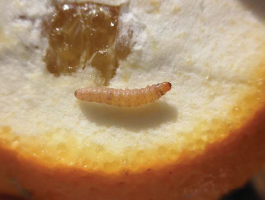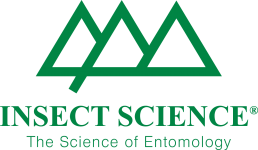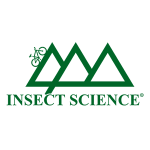Host plants
Apart from citrus, carob moth is known to infest carob pods, acorns, pomegranates, walnuts, macadamias, pecans and decaying apples, amongst other fruit and nuts, in addition to the fruit of certain wild trees such as milkplum, Englerophytum magalismontanum (Sapotaceae); sourplum, Ximenia cafffra (Oleaceae); and sweet thorn, Acacia karroo (Fabaceae).
Damage
Since carob moth larvae are usually larger than the neonate larvae of false codling moth when penetrating the fruit, the penetration holes caused by the former are generally larger. However, this may not always be the case. Penetration into the fruit is not as deep as with false codling moth and does not go beyond the albedo. However, as with false codling moth, granular frass can be found within penetration tunnels. Gumming exudes from the round puncture holes and infested fruit drop from the tree. The carob moth is a minor pest and occurs throughout southern Africa but usually infests with mealybugs or other honeydew-producing insects. Infestation may also be recorded where citrus is grown adjacent to a more favoured host, such as acorns, pomegranates or pecans or where the citrus fruit is already damaged, for example through navel-end splitting. Grapefruit appear to become more badly affected than other citrus cultivars.
Life history
The life cycle of the moth on citrus is southern Africa has not been studied in any detail. Elsewhere, the duration of development from hatching of the eggs to eclosion of the moths has been shown to be 24-37 days on carob pods at 25 ˚C and, at 29 ˚C on pistachio nuts, 33 days. In the field this was estimated to be between 32 and 50 days. An average of up to 340 eggs laid per female, over a 14-day period with 97% fertility, has been recorded. An estimated 4-5 generations occur per year, followed by a period of diapause during winter. Overwintering occurs in the larval stage within the host.
Natural enemies
Only one parasitoid of carob moth, the braconid wasp Phanerotoma laucobasis Kriechbaumer has been reared from infested acorns at Citrusdal in the Western Cape Province. Records from elsewhere include numerous parasitoids and predators, such as parasitic wasps of the families Encyrtidae Trichogrammatidae, Braconidae, Icheumonidae and Bethylidae, tachinid flies and ectoparasitic mites.
Management
Is it usually only necessary to inspect for carob moth when fruit is fairly heavily infested with mealybugs or other honeydew-producing insects. If dropped fruit is being evaluated for false codling moth infestation during summer, the presence of any carob moth larvae will also be detected. As carob moth and false codling moth larvae are similar in appearance, particular attention should be given to specific diagnostic differences.
As this pest is of minor importance or sporadic in nature, no thresholds have been defined for the timing of treatments. The control of mealybug or other honeydew-producing insects should result in a reduction in any carob moth infestation.
Orchard sanitation, i.e. the removal of infested fruit from the tree and dropped fruit from the ground, may assist in reducing the level of a carob moth infestation. Removal of favoured alternative hosts in close proximity to the citrus orchards should also help. This includes oaks, pecans and pomegranates.
No plant protection products are registered for the control of carob moth. Treatments are very rarely necessary to control this pest.






